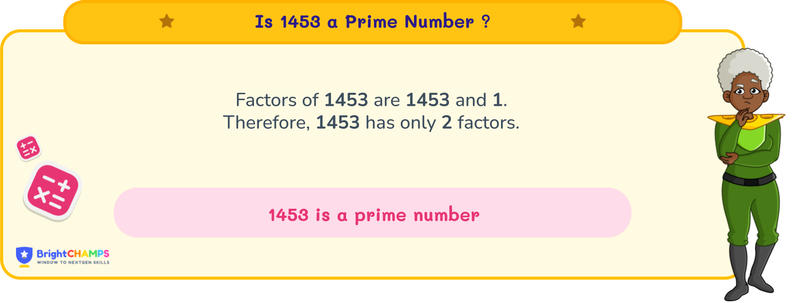Summarize this article:
 213 Learners
213 LearnersLast updated on August 5, 2025
Is 1453 a Prime Number?

The numbers that have only two factors, which are 1 and itself, are called prime numbers. For encryption, computer algorithms, barcode generation, prime numbers are used. In this topic, we will be discussing whether 1453 is a prime number or not.

Is 1453 a Prime Number?
There are two types of numbers, mostly — Prime numbers and composite numbers, depending on the number of factors. A prime number is a natural number that is divisible only by 1 and itself. For example, 3 is a prime number because it is divisible by 1 and itself.
A composite number is a positive number that is divisible by more than two numbers. For example, 6 is divisible by 1, 2, 3, and 6, making it a composite number.
Prime numbers follow a few properties like: -
- Prime numbers are positive numbers always greater than 1.
- 2 is the only even prime number.
- They have only two factors: 1 and the number itself.
- Any two distinct prime numbers are co-prime numbers because they have only one common factor, which is 1.
- As 1453 has only two factors, it is a prime number.


Why is 1453 a Prime Number?
The characteristic of a prime number is that it has only two divisors: 1 and itself. Since 1453 has only two factors, it is a prime number. A few methods are used to distinguish between prime and composite numbers. These methods include:
- Counting Divisors Method
- Divisibility Test
- Prime Number Chart
- Prime Factorization

Using the Counting Divisors Method
The method in which we count the number of divisors to categorize the numbers as prime or composite is called the counting divisors method. Based on the count of the divisors, we categorize prime and composite numbers. -
- If there is a total count of only 2 divisors, then the number would be prime.
- If the count is more than 2, then the number is composite.
Let’s check whether 1453 is prime or composite.
Step 1: All numbers are divisible by 1 and itself.
Step 2: Check divisibility by numbers less than the square root of 1453 (approximately 38). 1453 is not divisible by any number other than 1 and 1453 itself.
Since 1453 has only 2 divisors, it is a prime number.

Using the Divisibility Test Method
We use a set of rules to check whether a number is divisible by another number completely or not. It is called the Divisibility Test Method. For 1453: -
Divisibility by 2: 1453 is odd, so it is not divisible by 2.
Divisibility by 3: The sum of the digits in 1453 is 13, which is not divisible by 3.
Divisibility by 5: The unit’s place digit is 3, so 1453 is not divisible by 5.
Divisibility by 7, 11, 13, 17, 19, 23, 29, 31, 37: None of these numbers divide 1453 evenly.
Since 1453 is not divisible by any number other than 1 and itself, it is a prime number.

Using Prime Number Chart
The prime number chart is a tool created by using a method called “The Sieve of Eratosthenes.” In this method, we follow the following steps:
Step 1: Write numbers in a range, such as 1 to 1000.
Step 2: Identify known small prime numbers and eliminate their multiples.
Step 3: Continue the process of elimination using prime numbers. Through this process, 1453 is not eliminated, confirming it is a prime number.

Using the Prime Factorization Method
Prime factorization is a process of breaking down a number into prime factors and multiplying those factors to obtain the original number.
Step 1: Attempt to factor 1453 by any smaller prime number.
Step 2: Since 1453 is not divisible by any number other than 1 and itself, the prime factorization of 1453 is just 1453.

Common Mistakes to Avoid When Determining if 1453 is a Prime Number
People might have some misconceptions about prime numbers when they are learning about them. Here are some mistakes that might be made.

FAQ on Is 1453 a Prime Number?
1.Is 1453 a perfect square?
2.What is the sum of the divisors of 1453?
3.What are the factors of 1453?
4.What are the closest prime numbers to 1453?
5.What is the prime factorization of 1453?

Important Glossaries for "Is 1453 a Prime Number"
- Prime numbers: Natural numbers greater than 1 that have no divisors other than 1 and themselves.
- Composite numbers: Numbers that have more than two factors.
- Divisibility rules: Guidelines used to determine whether one number is divisible by another.
- Sieve of Eratosthenes: An ancient algorithm for finding all prime numbers up to any given limit.
- Co-prime numbers: Two numbers with only 1 as their common factor.

Explore More numbers
![Important Math Links Icon]() Previous to Is 1453 a Prime Number?
Previous to Is 1453 a Prime Number?
![Important Math Links Icon]() Next to Is 1453 a Prime Number?
Next to Is 1453 a Prime Number?


Hiralee Lalitkumar Makwana
About the Author
Hiralee Lalitkumar Makwana has almost two years of teaching experience. She is a number ninja as she loves numbers. Her interest in numbers can be seen in the way she cracks math puzzles and hidden patterns.
Fun Fact
: She loves to read number jokes and games.




